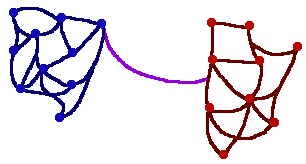Sora
The Sora is the term for the primordial chaos from which all realms form. The Sora is a wild and unpredictable place, akin to an endless ocean of roiling elemental energy.
Physical Properties
Composition
The Sora is composed of a roughly uniform mixture of the elements, including the fundamental elements, antielements, and demielements. These elements constantly shift and flow around each other, combining, annihilating, and emerging into being. In most locations, these elements are unpredictable, roiling with energy and shifting every few seconds. However, there do exist milder pockets of the Sora. The stablest locations are in the vicinity of realms, where the elements have collapsed into order. Most realms have a fairly large halo of air around them and their photopartum, allowing people to easily move around within the vicinity of the realm. Eddies are currents in the Sora which are relatively stable, but have not become entirely ordered. These eddies shift very slowly and typically contain less dangerous elements. Eddies can be incredibly long, stretching for many kilometers and branching one or more times, but are often quite narrow, only a few kilometers wide. Pockets of stable Sora, called nebulae, are less common. It is thought these nebulae will eventually collapse into realms.Size and regions
According to most theories, the Sora is infinite in size and expands forever. So far no physical edge has been discovered, though several expeditions have been launched to investigate. Many of these expeditions have never returned, presumably lost in the Sora. Those who have returned indicate encountering massive walls of instability with no eddies passing through them. Some have claimed such a thing as a physical boundary indicating the edge of existence, but such barriers have been encountered numerous times in the past and eventually eddies breaching them have been discovered or formed. The Sora tends to be organized in clusters or pockets. These clusters are groups of realms which are in relatively close proximity and have numerous eddies between them, often forming a web-like structure when mapped out. Clusters are separated by large swaths of chaotic Sora called walls, through which only a small number of eddies run. The diagram to the right displays a simplified example of two clusters with their realms (blue and red dots), eddies (dark blue and dark red lines), and the eddy that connects the two. Most clusters contain between 20 and 50 realms and connect to three or more other clusters. However, some smaller clusters containing less than 10 realms and isolated clusters with only one entry eddy have been found.Appearance
From a distance, the Sora is a dark black, as is seen in the night sky of many realms. However, traveling through the Sora reveals it to be a constantly shifting blend of colors as the elemental energy that make it up come into being, mix, transform, and annihilate each other. Aside from pockets of certain luminous elements, the Sora does not produce any light itself and can only be directly observed by shining light onto it. Conversely, light does not travel far through Sora before it is absorbed, hence the darkness of the night sky.Age and Evolution
As far as can be determined, the Sora always has existed and always will. The Dranomyr Archive claims to have existed for so long they stopped counting the years, perhaps millions or even billions of years. Aside from the Archive, the oldest civilizations in the Sora can trace their history back about 15,000 years. Beyond that, no one is certain on the age of the Sora. It is apparent that the Sora is not static, however. It has obviously changed significantly over the centuries and millennia, with new realms arising from the chaos. The exact mechanism of the creation of new realms is not fully understood, but some process causes a portion of the Sora to grow more ordered and eventually collapse into a realm. Some posit that the gods cause the Sora to collapse, while others claim that the gods only arrive after the realm is created. Regardless, there are numerous barren realms with seemingly no gods and life on them. It appears new realms form in bursts over the course of a few thousand years, as the current empires can trace their histories back between 10 to 15,000 years ago.Dangers
In most locations, the Sora is incredibly violent and dangerous. Contact with the Sora swiftly leads to destruction for most things, either from physical contact with a harmful element or through the release of energies from their combinations. Living creatures that come into contact with raw Sora typically die within a matter of minutes, either from being burned, melted, electrocuted, smashed, ripped apart, drained of life, exploded, or suffocated. Non-living things can survive somewhat longer depending on its sturdiness; objects made of metal can last for several years, those of wood several months, and more fragile things several days. The eddies and nebulae are relatively calmer areas and thus are far more survivable. While the occasional burst of extreme elements occurs, they usually pass within a short time, only temporarily causing issues. Unprotected living creatures can live for hours or days, though they are likely to suffer from burns, shocks, extreme temperatures, and other perils. Protected creatures can survive for as long as their protection lasts or they die from starvation or dehydration. Objects can similarly last nearly indefinitely, though more fragile ones may run into a small amount of dangerous elements and be destroyed.Travel
Despite the dangers of the Sora, travel through it is possible and even commonplace, with much the same risks as faced by sailors during many realms' ages of sail. It is accomplished via soracraft, specialized vessels designed to travel on the natural flows of the eddies and venture from realm to realm. Three major type of soracraft are in common use: soraships, lepicephs, and crystalles. Each has been treated to withstand the calm elements within the eddies as well as survive for a short time in more turbulent areas. Soraships, the most common method of travel, utilize specialized crew known as navigators or pilots to operate. These navigators must have a natural attunement and sensitivity to the elements, which allows them to sense the currents, stay within the proper eddies, and avoid any chaotic pockets. Because these individuals are relatively rare (about 1 in 10,000 people are estimated to be capable of it, less are interested in doing so), they are in high demand, though training is not incredibly difficult.
Type
Natural




Comments